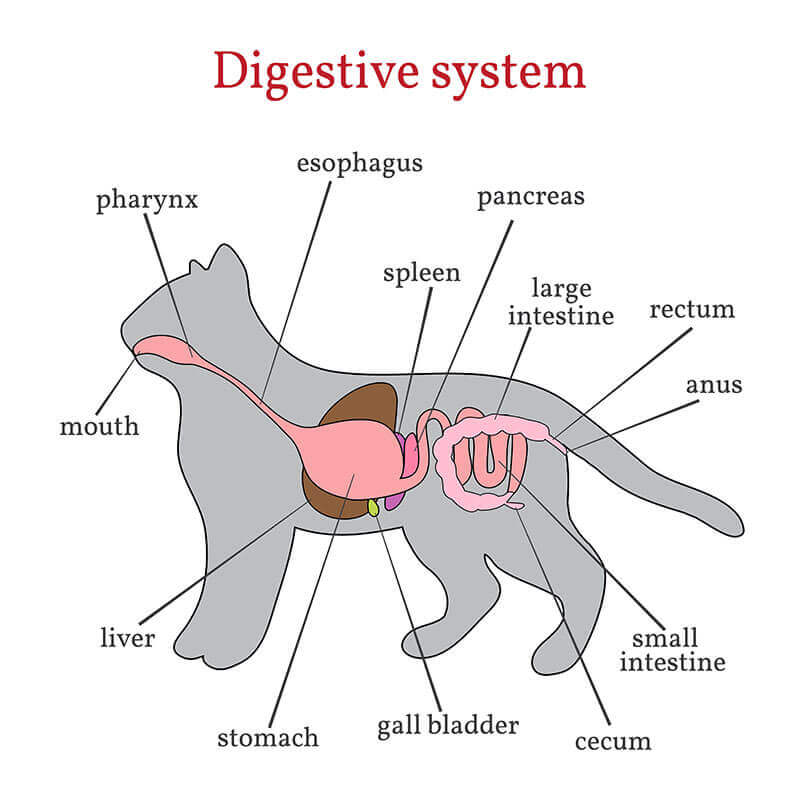The Causes and Symptoms of Dysentery in Cats


Written and verified by biochemistry Luz Eduviges Thomas-Romero
Dysentery in cats, as well as in other animals, is characterized by liquid or semi-liquid evacuations with the presence of blood. We’ll tell you all you need to know about the causes and symptoms of this illness in the following article.
Dysentery in cats can be difficult to detect
Some of the most common problems in cats are diarrhea and gastrointestinal discomfort. Even so, according to a cat’s lifestyle, it’s possible for owners to be unaware of their pet’s bathroom habits.
Most cats defecate once a day. In the case of a normal bowel movement, the smell should not be overbearing. Furthermore, it should have a consistency that makes it easy to scoop from the litter box.
That being said, the presence of blood in a cats’ stools can be hard to identify. If this blood originates from the feline’s lower intestinal tract, then it will likely have the appearance of fresh blood. This is especially true if it comes from the distal colon – the large intestine – or the rectal region. How can you detect it? Most often you’ll discover red or pink spots around the edge of your pet’s litter box or at the upper tip of its feces.
On the other hand, blood in a cat’s feces may also be black or brown in color. This happens when the blood originates from the upper intestinal tract – particularly the small intestine. This change in color is the result of the partial digestion of the blood by enzymes that the small intestine secretes. This blood will often appear in the form of dark spots or speckles, or may look like coffee grounds.
It’s important to keep in mind that both constipation and diarrhea can cause blood in a cat’s feces. Bright red blood without diarrhea and/or hard, dry feces are both usually an indication that the problem lies closer to the rectum or anus.

What are the causes of dysentery in cats?
If we were to name all of the factors that can lead to dysentery in cats, the list would be very long. So, here are some of the general categories:
- Parasites
- Viral and bacterial infections
- Dietary indiscretion or abrupt changes in an animal’s diet
- Stress: Stress, anxiety and excitation can all lead to colitis
- Primary inflammatory disorders
- Metabolic illnesses: From disorders of the pancreas and liver to thyroid imbalances, there are many other problems that alter a cat’s motility or the environment of its gastrointestinal tract. All of these factors can produce diarrhea with blood.
- Medications and toxins: Not many know that certain medications, including some antibiotics, can alter a cat’s gastrointestinal tract. The same is true of certain toxins.
How to act if you suspect your cat has dysentery
As we mentioned above, there’s a long list of factors that can cause dysentery in cats. Therefore, it’s important to consult with your veterinarian regularly. It’s obvious that many cases of diarrhea require specific therapy. In the case of dysentery, you should always check with a veterinarian regularly.
Besides veterinary attention, it’s also extremely important that you maintain your cat’s hydration level. It’s very important to avoid dehydration and electrolyte imbalances.

The symptoms of dysentery in cats
Perhaps your cat’s excrement is somewhat soft but he or she is still happy, playful, and has a good appetite. If that’s the case, in general, you can probably wait and see what happens with the next bowel movement. Below are several symptoms you should be on alert for:
- Loss of appetite
- Lethargy or depression
- Pain or discomfort
What should you do if you notice blood in your cat’s feces?
Any time that you notice blood in your cat’s feces you should let your veterinarian know right away. Keep in mind that loose stools during the morning can produce dehydrating diarrhea during the night.
Blood in a cat’s stools, whether it’s red or black, is always a cause for concern. Blood that is dark in color and has already been digested can be a sign of a serious issue. In the case of fresh blood that is still red, it can be an indication of anything from benign food changes to cancer.
In conclusion, if you notice anything strange in your cat’s feces, don’t delay in seeking veterinary care. Don’t wait for the problem to go away on its own. The best thing you can do is observe your cat’s litter box regularly in order to respond appropriately in the case of any irregularities.
Dysentery in cats, as well as in other animals, is characterized by liquid or semi-liquid evacuations with the presence of blood. We’ll tell you all you need to know about the causes and symptoms of this illness in the following article.
Dysentery in cats can be difficult to detect
Some of the most common problems in cats are diarrhea and gastrointestinal discomfort. Even so, according to a cat’s lifestyle, it’s possible for owners to be unaware of their pet’s bathroom habits.
Most cats defecate once a day. In the case of a normal bowel movement, the smell should not be overbearing. Furthermore, it should have a consistency that makes it easy to scoop from the litter box.
That being said, the presence of blood in a cats’ stools can be hard to identify. If this blood originates from the feline’s lower intestinal tract, then it will likely have the appearance of fresh blood. This is especially true if it comes from the distal colon – the large intestine – or the rectal region. How can you detect it? Most often you’ll discover red or pink spots around the edge of your pet’s litter box or at the upper tip of its feces.
On the other hand, blood in a cat’s feces may also be black or brown in color. This happens when the blood originates from the upper intestinal tract – particularly the small intestine. This change in color is the result of the partial digestion of the blood by enzymes that the small intestine secretes. This blood will often appear in the form of dark spots or speckles, or may look like coffee grounds.
It’s important to keep in mind that both constipation and diarrhea can cause blood in a cat’s feces. Bright red blood without diarrhea and/or hard, dry feces are both usually an indication that the problem lies closer to the rectum or anus.

What are the causes of dysentery in cats?
If we were to name all of the factors that can lead to dysentery in cats, the list would be very long. So, here are some of the general categories:
- Parasites
- Viral and bacterial infections
- Dietary indiscretion or abrupt changes in an animal’s diet
- Stress: Stress, anxiety and excitation can all lead to colitis
- Primary inflammatory disorders
- Metabolic illnesses: From disorders of the pancreas and liver to thyroid imbalances, there are many other problems that alter a cat’s motility or the environment of its gastrointestinal tract. All of these factors can produce diarrhea with blood.
- Medications and toxins: Not many know that certain medications, including some antibiotics, can alter a cat’s gastrointestinal tract. The same is true of certain toxins.
How to act if you suspect your cat has dysentery
As we mentioned above, there’s a long list of factors that can cause dysentery in cats. Therefore, it’s important to consult with your veterinarian regularly. It’s obvious that many cases of diarrhea require specific therapy. In the case of dysentery, you should always check with a veterinarian regularly.
Besides veterinary attention, it’s also extremely important that you maintain your cat’s hydration level. It’s very important to avoid dehydration and electrolyte imbalances.

The symptoms of dysentery in cats
Perhaps your cat’s excrement is somewhat soft but he or she is still happy, playful, and has a good appetite. If that’s the case, in general, you can probably wait and see what happens with the next bowel movement. Below are several symptoms you should be on alert for:
- Loss of appetite
- Lethargy or depression
- Pain or discomfort
What should you do if you notice blood in your cat’s feces?
Any time that you notice blood in your cat’s feces you should let your veterinarian know right away. Keep in mind that loose stools during the morning can produce dehydrating diarrhea during the night.
Blood in a cat’s stools, whether it’s red or black, is always a cause for concern. Blood that is dark in color and has already been digested can be a sign of a serious issue. In the case of fresh blood that is still red, it can be an indication of anything from benign food changes to cancer.
In conclusion, if you notice anything strange in your cat’s feces, don’t delay in seeking veterinary care. Don’t wait for the problem to go away on its own. The best thing you can do is observe your cat’s litter box regularly in order to respond appropriately in the case of any irregularities.
All cited sources were thoroughly reviewed by our team to ensure their quality, reliability, currency, and validity. The bibliography of this article was considered reliable and of academic or scientific accuracy.
- Vaden, S. L., Knoll, J. S., Smith Jr, F. W., & Tilley, L. P. (Eds.). (2011). Blackwell’s Five-Minute Veterinary Consult: Laboratory Tests and Diagnostic Procedures: Canine and Feline. John Wiley & Sons.
- Willard, M. D., & Tvedten, H. (2011). Small Animal Clinical Diagnosis by Laboratory Methods-E-Book. Elsevier Health Sciences.
- Greene, C. E. (2013). Feline Enteric ViralInfections. Infectious Diseases of the Dog and Cat–E-Book, 80.
This text is provided for informational purposes only and does not replace consultation with a professional. If in doubt, consult your specialist.








